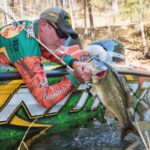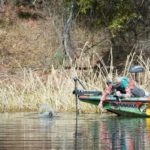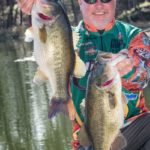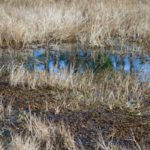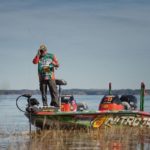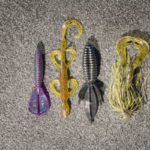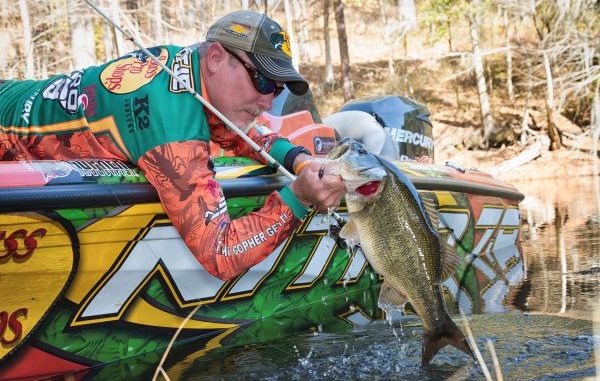
The bitter cold that gripped the state the past few months is actually good news for Toledo Bend anglers looking to catch bedding bass. Here’s why.
If there has ever been a colder winter at Toledo Bend, Bassmaster Elite Series pro Dennis Tietje cannot remember it.
But, strangely enough, the cold weather didn’t seem to have much of an impact during the brunt of its grip: Borne out by several texted photos, Tietje caught bass during the middle of the swirling snow.
But now?
The cold that didn’t want to go has left a delayed mark on Toledo Bend.
I got a firsthand look at the effects of the cold just a few weeks ago as I backed Tietje’s Nitro tournament rig off the trailer.
“42,” I told him as he jumped in.
“That’s about 10 to 15 degrees colder than it was this time last year,” Tietje grumbled, as he settled in behind the steering wheel. “They were hard on the bed last February. I don’t think we’re going to see that today.”
We didn’t.
According to Tietje’s calculation, the ruthless winter has put the Toledo Bend bass spawn a month behind schedule.
“Normally, we have a big wave of fish come in during February to spawn,” he said as we idled away from the ramp, “but the water is colder than I’ve seen it in a long time. I would expect it to be in the mid-50s by now.”
But what discouraged several anglers who tried to shake off the February cold is going to be a boon for those of us who wait until April before we seriously attack the bass.
To understand what is happening this year, one must first take into consideration the enormity of Toledo Bend and its effect on the timing of the spawn.
Most notably, the shallower and murkier lake north of Pendleton Bridge generally runs a few degrees warmer than the deeper and clearer portion of the lake south of the bridge.
Since shallow, murky water generally warms up quicker than deep, clear water, the Toledo Bend bass spawn kicks off up north several weeks before it does down south.
“That’s not the case this year, though,” said Tietje. “The cold winter has evened out the lake. During a normal year, it seems like the north turns on faster; however, this year, with the snow and sleet, it seems like the cold, murky water of the north doesn’t have much advantage over the cold, clear water of the south.”
No wonder Tietje has seen fish moving up at the same time no matter which direction he points the bow of his boat.
Just as important are the three different phases of the spawn at Toledo Bend.
Tietje said these phases can best be explained by correlating them to waves of fish that move up to spawn at different times.
“The first phase is when we see fewer but bigger fish move in, he noted. “Our second phase usually comes a month later, and this is when we see the really big move of fish into the shallows to spawn.
“The third phrase generally happens a month later, and this is when a lot of fish that live deep move up last.”
February, March and April usually line up perfectly with the first, second and third phrases.
But this year, even though some initial bass tried to move up during the February full moon, those three phases are more likely to line up with March, April and May.
For anybody paying attention, that means April is when Tietje expects to see the big wave of fish move up to spawn, whereas the spawn would generally be wrapping up about this time of the year.
And as far as Toledo Bend goes, there’s no better time to be a bank beater than during the second phase of the spawn.
If that’s you, Tietje said to pay particular attention to the presence of what he called shore grass.
“It’s growing out into 3 and 4 feet of water, and it’s kind of like hydrilla or milfoil in the way it lays on the surface, but underneath is very open,” he explained. “It grows good in sandy areas, and it has created an excellent habitat for the fish to spawn in.”
Since there is so much of this grass lining the banks, Tietje has a very simple method of dissecting it to fish only the high-percentage areas.
The only two areas where sunlight can penetrate to the bottom around this grass are at its edges and inside open holes.
“You’ll see a lot of beds along the edges, but every one of those holes will have a bed in it sooner or later,” Tietje said. “So by fishing the holes, you don’t have to actually see them on the beds to catch spawning fish.”
Although this grass in the very ends of the pockets, creeks and coves is likely to hold spawning bass, Tietje said there will be so many fish up this month that anywhere from the very backs to the mouths of the creeks will likely hold spawning fish.
“Secondary points can be very good during the second phase of the spawn,” he continued. “Just find you a little area protected from the wind. That’s where you want to fish.”
Up north, Tietje pointed out Patroon as being one of the premier spawning areas, as is the 1215 area. But he wouldn’t forget about trying the north banks of San Miguel and San Patricio.
And down south? Tietje spends a lot of time targeting spawning bass in Hurricane Creek, Housen, Six Mile and Pirates Cove.
Techniques to catch spawning fish at Toledo Bend are as numerous as the spots where they spawn. However, where one chooses to fish will go a long way in determining how the angler should fish.
According to Tietje, there are two kinds of sight fishing in play during the spawn. One, which is more prevalent down south, is a matter of actually seeing the fish. The other, which is more of a necessity up north, is seeing clues that give a fish’s location away.
“In that murkier water up north, I rely on finding spawning fish by watching them pushing waves as they run off the baitfish,” Tietje said. “When I start seeing those circles produced by protective bass, I know there’s a bed there, so it’s kind of like sight fishing without actually seeing the fish.”
And if he can’t see this activity up north, Tietje kind of imposes his will by fishing Strike King Red Eye Shads or spinnerbaits close to the bottoms of standing wood to force them to run out and push his bait when it comes over their beds.
Down south, Tietje winds up fishing for fish he can actually see on their beds.
By his own admission, he would rather not bed fish like this because of how temperamental the bass can be, but that doesn’t stop Tietje from setting up shop where he can just barely spot the fish.
“I like to throw a creature bait in there on them,” he pointed out. “I believe a bass on a bed is more apt to hit that over a straight worm because something like a Strike King Rage Menace intimidates the fish, and they think it’s in there trying to eat the eggs — they respond to it a lot faster than a worm.”
Tietje’s theory is that any kind of soft plastic that can stand on its nose in the water imitates a predator eating the eggs, thus triggering a strike from a fish that really doesn’t want that bait in there.
But Tietje’s favorite way to catch spawning bass doesn’t involve him seeing a bass or a bed.
Rather than spending a lot of time staked out on skittish bass, he would rather back out to the inside grass line and fish for bedding bass nobody can see.
“I like to back out to 3 to 7 feet (of water) and use some kind of slow presentation,” he said. “I try to keep on that inside grass where the hydrilla stops and the sandy bottom starts.
“These kinds of areas are key to catching bigger bedding bass.”
His slow presentations include casting a lizard or a small creature bait on a light sinker or floating a Strike King Ocho or a Senko over the tops of these deeper beds.
“But what I’ve found here lately is that there is a lot of activity on this inside grass line on some kind of hard jerk bait,” he said, “which allows me to aggressively cover a lot of water with a bait that I can also pause and sit it there right in the middle of a bed.”
If the inside grass line is 3 feet deep or shallower, Tietje prefers a floating jerk bait that won’t dig into the grass or the bottom. In this case, he wants his lure to ride high and sometimes stay on the surface.
“If I’m out in 5 feet (of water), I want a bait that stays down there in the water closer to the bed,” he continued. “The closer I can get that bait to the bed without disturbing the area the better reaction I’ll get from the female fish. Then I’ll tie on a suspending bait.”
jerkbait should really shine this April, as there will be a bunch of shallow bass that have already spawned mixed in with a bunch of fish that are actively spawning.
“These fish are predators of themselves, so when you get a bunch of post-spawn bass hanging out around a bunch of spawning bass — that’s a good recipe for a jerk bait,” said Tietje.
Tietje expects the absolute best time to be on the lake will be the week of the full moon, which will the be week of the March 15.
“If you want to plan a trip, that’s the week to do it,” he said. “Fish will be up spawning all month long, but there should be a massive wave move in around that full moon. We used to think that the water had to be in the mid 60s before bass would spawn, but the moon phase is more critical than anything.”
We saw the effects of the full moon during our February trip. Even after such a brutal winter, bass that Tietje had been catching in 10 to 15 feet of water moved up to hardly a foot or 2 of water seemingly overnight.
They weren’t spawning, but they sure were thinking about it.
Come April, there won’t be much to think about.
